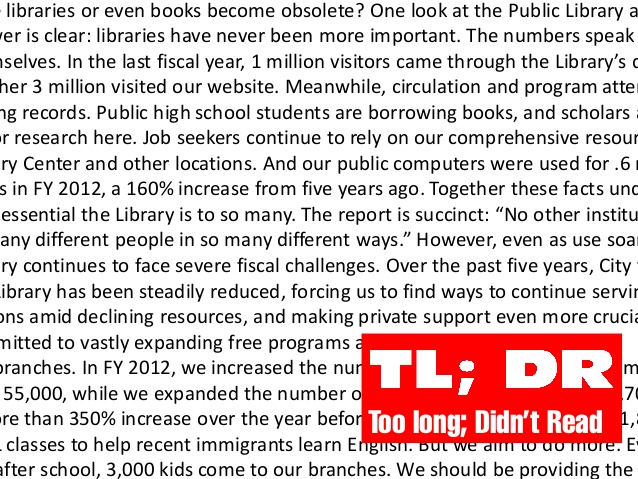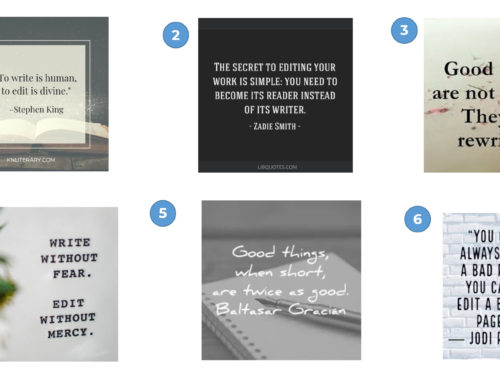 Nonprofit leaders often complain about limited resources — and with good reason. After all, even the best-run nonprofits lack the money or the staff to accomplish everything they set out to do. But while money is tight, there’s one resource that is almost always in ample supply: words.
Nonprofit leaders often complain about limited resources — and with good reason. After all, even the best-run nonprofits lack the money or the staff to accomplish everything they set out to do. But while money is tight, there’s one resource that is almost always in ample supply: words.
Often, nonprofit websites and print materials are burdened with way too much text.
As a writer, I understand the urge to use the written word to engage readers and convey information. But in a TL;DR world (shorthand for “too long; didn’t read”), your nonprofit stands to lose attention if it relies only on narrative pieces to spread its message.
Many nonprofits already use video and audio as part of its content mix. However, with limited resources — and multiple audiences that you need to reach — it’s likely that you need to lean on text for most of your content.
That’s where many nonprofits struggle. Take a look at the written content created by many nonprofits, and you’re greeted with walls of text that intimidate readers.
And when readers see long blocks of text, they tune out.
But even if your nonprofit relies heavily on the written word, you can still deviate from traditional narrative formats. In fact, you’re more likely to draw attention and engage your key audiences if you mix things up a bit.
Sometimes, a long article or report is necessary.
The rest of the time, though, think about how to pivot away from more traditional approaches and toward formats that will provide your audiences with something different.
Replace the walls of text with some creative narrative styles and you’ll see greater engagement (and you’ll have a lot more fun creating the content, as well).
Here are six alternatives to traditional narratives that you can employ with your nonprofit’s content:
1. The format: Q & A
An alternative to: Profiles
Many nonprofits use profiles to help put a face on their work. Education nonprofits often profile graduates or teachers. Foundations profile grantees.
And while profiles can humanize your work and provide readers with an easy way to see your organization’s impact, you don’t have to rely on a narrative structure to tell these stories.
Consider instead a Q & A (or question-and-answer) format. Q & A’s offer readers an accessible way to learn about a person and his or her opinions.
Paired with a strong photograph, they can help you tell a story quickly — and they are often easier to put together than a long narrative.
This can help you cover more ground — all while giving your readers something easy to digest.
Example: Teach for America’s profile of Ankur Arya
2. The format: Timeline
An alternative to: About Us/History
Your nonprofit likely devotes a page on its website and a section of its annual report to share information about its history. And, often, you need to tell stories about the evolution of a program or idea.
Rather than telling that (sometimes long) story in a wordy narrative, share it in a timeline.
You can find a number of easy-to-use timeline creation tools online if you don’t have a designer at the ready — and you’ll make it much easier for your key audiences to digest and understand your story.
3. The format: Case Study
An alternative to: Impact stories
When it’s time to celebrate an accomplishment — or discuss how your nonprofit overcame an important challenge — consider doing it as a case study rather than as a simple article.
Case studies can be presented as short, bite-sized pieces or long, downloadable whitepapers. But however you decide to present them, they offer a great alternative to an article or blog post — and they make it easy for readers to understand the impact of your work.
4. The format: Quiz
An alternative to: Articles
The American Red Cross isn’t just about disaster response. Part of its mission is to help the public prevent and prepare for emergencies.
Often, that means it needs to provide information about topics such as how to prevent a home fire or and how to make sure your family is safe during a tornado or hurricane.
Rather than simply providing written guides and articles about these topics, the organization has developed a series of online quizzes that give readers a way to think about and digest information that will help them prepare for emergencies.
By giving them a tool that allows them to engage with the information, readers are more likely to access and retain the information.
Example: Are You Prepared for a Home Fire?
5. The format: Checklists
An alternative to: Articles
Similar to a quiz, a checklist gives readers of informational content something to do. Rather than simply writing about how to prepare for or accomplish something, break it into a list and present it as something readers can use.
6. The format: Alternative Listicles
An alternative to: Listicles
Buzzfeed — the purveyor of online gems such as 10 Important Life Lessons You Can Learn from Cats — has spawned a form of content commonly referred to as the listicle.
Listicles are essentially articles that are repackaged as lists — and many nonprofits have joined the growing legion of content creators who already use listicles as an alternative to the basic article.
The problem is that listicles are now so common that they have become a bit trite (even though we all know you’re dying to click on that link about cats and life lessons).
Consider instead the alternative listicle. This is a listicle that doesn’t just present a list, it offers an alternative to each item on that list.
This blog post is actually an example of an alternative listicle, since each item on the list is actually an alternative to something else.
And that brings me to my final point — which is simply to be creative when you think about your content.
It’s easy to revert to traditional styles and approaches when you’re presenting information. But take some time to think about how you can present those words in another format — or even how you might twist a popular format for your own devices.
Your readers will thank you for it.






